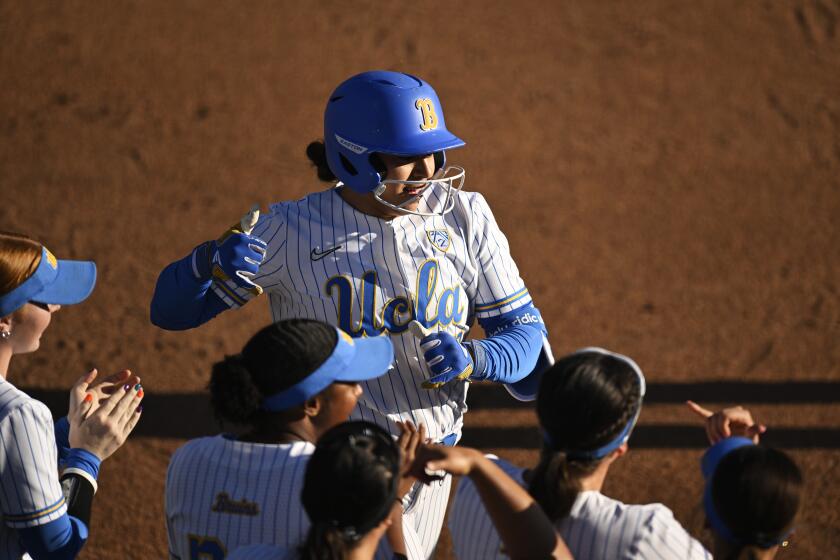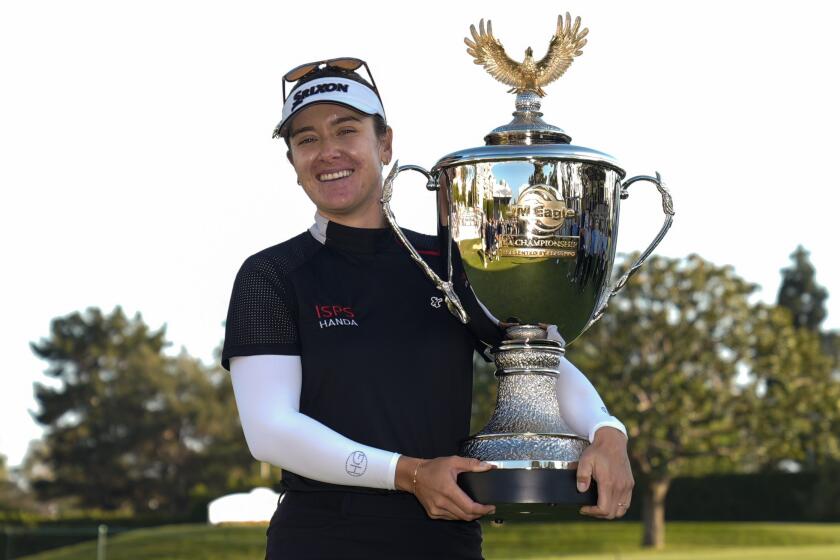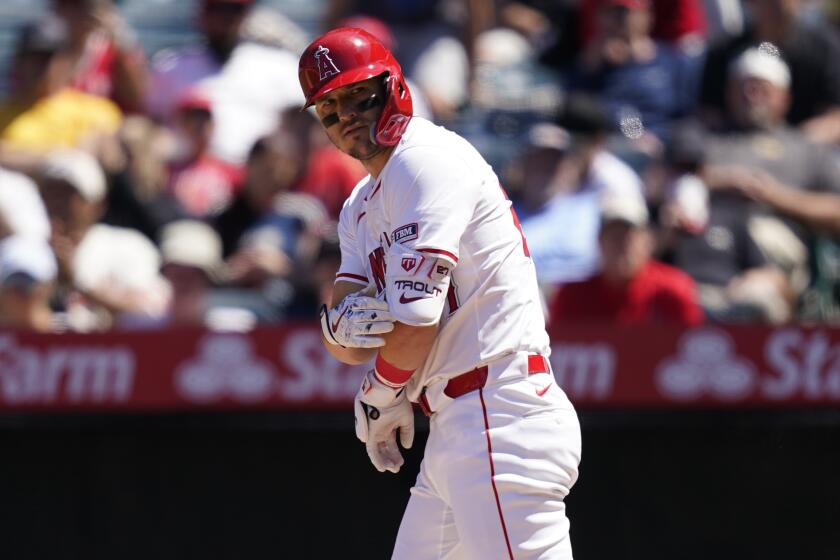For horse racing, death has no easy answers
On the Monday after, when it should have been just the opposite, the sport of horse racing was riding low in the saddle.
Saturday, at the grotto of the sport, a star named Big Brown was born into public consciousness by storming down the homestretch, under the twin spires of Churchill Downs, and winning the Kentucky Derby in dominating fashion.
It was what racing wanted, needed, lusts after. There hasn’t been a Triple Crown winner since Affirmed in 1978, and the projection of such a star seems to be the sport’s perceived trampoline to growth.
Big Brown started in the 20th hole, so far from the rail and from access to the shortest trip around the 1 1/4 -mile route that, despite obviously superior talents, many experts figured a win was unlikely. When he powered past the field to finish nearly five lengths in front, racing stood on top of the mountain and shook its fists in joy.
Less than a minute later, the fists unclenched and the joy drained.
Once again, at a key moment, in a high-profile race, a horse had broken down. The story wasn’t victory and glory now. It was death.
Eight Belles, a filly who had run against 19 boys and beat all but one of them, collapsed about a quarter of a mile past the finish line. She was almost at full stop when both ankles suddenly fractured, one break piercing the skin and opening up to the likely contamination that brings the decision to put the horse down. Which is what happened.
By Monday, racing was sitting on a folding chair in a windowless room with flood lights glaring down. Instead of celebration, it got inquisition.
The questions came fast and furious, anyway. The answers are more elusive.
What’s wrong with thoroughbred breeding that so many great ones break down? Barbaro did so two years ago in the Preakness, then George Washington in last year’s Breeders’ Cup. And who can forget, no matter the passage of time, the agony of Ruffian and Go For Wand, limbs dangling grotesquely?
Should fillies be allowed to race against colts? Is there a gender-related physical flaw?
Is the pressure of a Triple Crown, with the three most important races of their lives spread over only five weeks, simply too much physically for a 3-year-old to handle?
And what about jockeys whipping horses down the stretch?
Nicole Matthews, a spokeswoman for PETA, the animal rights group, went on ESPN radio to label racing “a dirty, greedy money game.” She also characterized jockey Gabriel Saez’s stick work down the stretch on Eight Belles as “vicious whipping” and called for his suspension.
The lines were drawn and racing, once again, was forced into a mode best described as emotionally sad and steadfastly unapologetic.
Hall of Fame jockey Chris McCarron, who now teaches apprentices in Kentucky, said, “I saw it and my heart went into my mouth.” He said that to blame Saez for any wrongdoing was “the most ludicrous thing I have ever heard.”
Mike Smith, who rode Gayego to a 17th-place finish and was galloping out no more than 50 yards behind Eight Belles when she collapsed, said, “Larry Jones [Eight Belles trainer] loved that horse like she was his daughter.” On the issue of Saez’s whipping, Smith said, “This was his best horse ever. He was just doing his job. There’s no need to crucify him. He’s crucifying himself enough right now.”
D. Wayne Lukas, Hall of Fame trainer, quartered in Louisville, Ky., said, “We don’t need this exposure, especially on our biggest days.” Lukas, who won the Derby with Winning Colors in 1988, the last filly to do so, said that filly versus colt wasn’t the issue. Competitive desire was. “She would have run just as hard and tried just as much if it was a third race on a Wednesday afternoon,” he said.
Richard Shapiro, president of the California Horse Racing Board and the man most responsible for the recent controversial conversion of four California tracks to synthetic surfaces that are projected to be safer, called the death of Eight Belles “tragic and horrible.” He hastened to add that, even though it happened on the dirt at Churchill, he wants in no way to use it as an I-told-you-so. “We see this over and over again,” he said, “and we just need to fix it.”
E.W. “Bud” Johnston of Old English Rancho farms near Fresno, a veteran of 51 years in the horse-breeding business, said, “This is very sad to see. It’s also very sad to see that the press only wants to concentrate on this death when we just had perhaps the best horse since Seattle Slew win the Derby.”
Johnston, who has bred more than 4,000 race winners and more than 200 stakes-winners while having fewer than 10 catastrophic breakdowns, said that 1,000-pound thoroughbreds, carrying 125 pounds and traveling nearly 35 35 mph, strike the ground at an impact level of 5,500 pounds per square inch.
“If the surface doesn’t give, you have injuries,” he said. “But if it gives too much, you also have injuries.”
Johnston agreed that the North American approach to breeding is an issue. “In Europe, they breed for the horses,” he said. “Here, we breed for the public.”
He says he tries to avoid inbreeding flaws. If a stallion has a bad knee, he will avoid breeding him to a mare with a bad knee.
But he admits no system is perfect. “I think it is fair to say that we have bred more improvement into the horse’s musculature structure than into its skeletal structure.”
The issue has also been raised that, since horses are allowed to run in North America with therapeutic drugs in their system, perhaps many horses are competing with flaws that are masked and then perpetuated in the breeding shed. “Any weakness you don’t spot, chances are you’ll pass that along,” Johnston said. “You do your best not to inbreed problems.”
Chances are, the horse is out of the barn on that, and many of these issues. The hope for the future seems to be the perfection of synthetic tracks, flawed and controversial as that is.
There is no question that racehorses will always break down. One thousand pounds supported by toothpicks is a recipe for disaster.
Nor is anybody proposing an answer to the need for speed. As Johnston said, there are no suggestions for increasing races to 2 1/2 miles.
Or, as Lukas said, “I’ve got a couple of really sound, healthy horses in my barn right now, and boy, are they slow.”
While racing thrashes around with its image and its reality, the public watches and gets nauseated.
Manager Mike Scioscia strolled past a TV set Saturday afternoon in the clubhouse. His Angels had finished their 3-1 win over Baltimore in time to watch the Derby, and now it was time for the replays.
Scioscia kept right on strolling.
“I won’t even watch it,” he said, sadly summing up the public’s current stance, as well as the sport’s worst fear.
--
Bill Dwyre can be reached at bill.dwyre@latimes.com. For previous columns by Dwyre, go to latimes.com/dwyre.
--
Begin text of infobox
Horse breakdowns
Famous horses that have broken down in big races:
* Eight Belles, 2008: About a quarter-mile after finishing second in the Kentucky Derby, the filly breaks both front ankles and has to be euthanized in front of 157,770 at Churchill Downs.
* George Washington, 2007: Breaks down 100 yards from the finish in the Breeders’ Cup Classic in the mud at Monmouth Park, breaking bones in his right foreleg. The horse has to be euthanized.
* Barbaro, 2006: Kentucky Derby winner fractures three bones in and around the ankle of his right hind leg in front of the grandstand, about a quarter-mile into the Preakness. Despite six surgeries, the horse had bouts with laminitis and had to be euthanized eight months later.
* Pine Island, 2006: The 3-1 second choice in the Breeders’ Cup Distaff at Churchill Downs falls on the backstretch, suffers multiple fractures and has to be euthanized.
* Charismatic, 1999: Going into the Belmont as the 2-1 favorite after having won the Kentucky Derby and the Preakness, Charismatic holds the lead going into the final furlong. However, the horse fades and finishes third behind Lemon Drop Kid and Vision and Verse. Sensing trouble after passing the wire, jockey Chris Antley jumps off the horse and holds up the colt’s left front leg, broken in two places. Many say Antley’s actions saved Charismatic’s life. The horse underwent career-ending surgery the next morning.
* Prairie Bayou, 1993: On a drizzly day at Belmont Park, Prairie Bayou, who had run second at the Kentucky Derby and first at the Preakness, buckles in the backstretch about half a mile into the race. Jockey Mike Smith jumps over the horse’s right side and escapes injury, but the horse suffered compound fractures in his left foreleg and had to be euthanized about 30 minutes later.
* Go For Wand, 1990: Snaps right front ankle and tosses jockey Randy Romero toward the outside rail during the Breeders’ Cup Distaff at Belmont Park. Go For Wand gets up and hobbles on three legs, with the mangled part of her fourth limb dangling before the horse collapses. She was euthanized in front of the grandstand.
* Ruffian, 1975: In a match race against Kentucky Derby winner, Foolish Pleasure, Ruffian hits her shoulder on the starting gate. She recovers quickly but looks to be running in pain and leans heavily on her right foreleg. A furlong past the quarter-mile pole, Ruffian is in front by half a length when both sesamoid bones in her right foreleg snap. Jockey Jacinto Vasquez tries to pull her up, but the filly wouldn’t stop, pulverizing her sesamoids, ripping the skin of her fetlock as the bones burst through and tearing her ligaments until her hoof was flopping uselessly. Surgery repairs the damage, but the horse thrashes about after the anesthesia wears off, reinjures herself and has to be euthanized.
--
Source: Los Angeles Times research
More to Read
Get our high school sports newsletter
Prep Rally is devoted to the SoCal high school sports experience, bringing you scores, stories and a behind-the-scenes look at what makes prep sports so popular.
You may occasionally receive promotional content from the Los Angeles Times.







